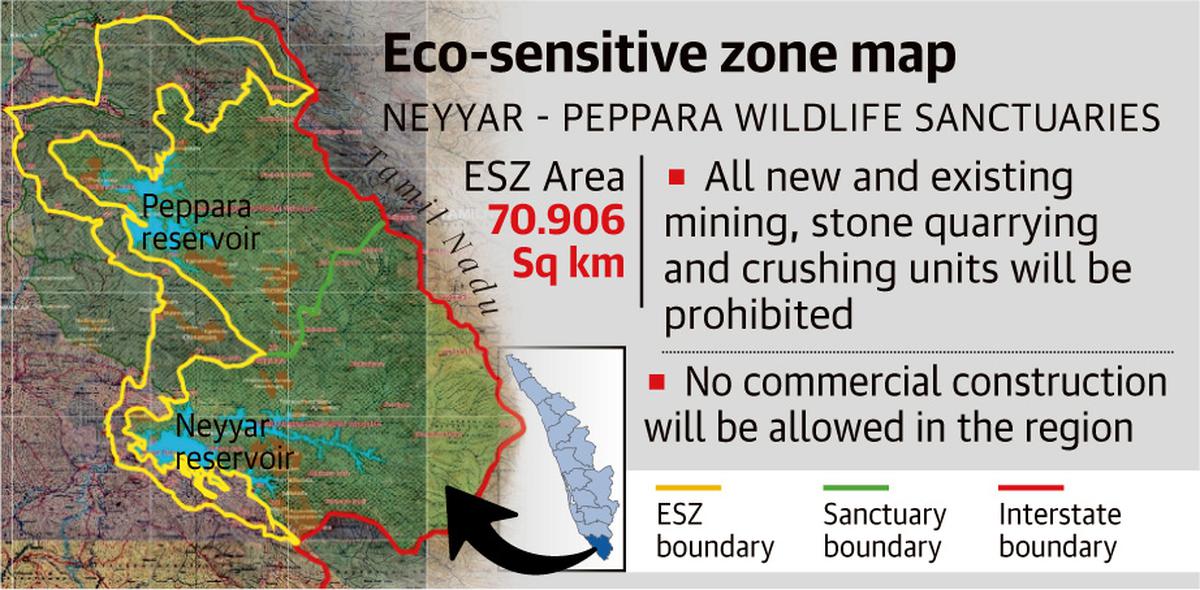Context
-
Recently, the Ministry of Environment, Forests and Climate Change (MoEFCC) issued a draft notification to declare an Eco-Sensitive Zone (ESZ) that will encompass large swathes of human-inhabited areas around the Neyyar and the Peppara wildlife sanctuaries in Thiruvananthapuram.
About Neyyar and Peppara wildlife sanctuaries
- The two sanctuaries, which form part of the core area of the Agasthyamalai Biosphere Reserve in the Western Ghats, are known to be blessed with rich biodiversity.

Credit: The Hindu - Studies have discovered around 1000 species of flowering plants that belong to 132 families in the protected areas.
- Besides, they are known to sustain diverse fauna including 43 mammal species, 233 bird species, 46 reptile species, 13 amphibian species, 27 marine species and a wide variety of butterflies and odonates.
- The endangered Myristica swamps are also endemic to the protected areas.
- The proposed ESZ that extends to a maximum of 2.72 km in the west and 2.39 km in the northwest directions from the boundaries of the sanctuaries is intended to preserve such ecological abundance.
- The Peppara Wildlife Sanctuary is a wildlife sanctuary in Thiruvananthapuram district of Kerala, India. It consists of the catchment area of the Karamana River, which originates from Chemmunjimottai, the tallest hill within the sanctuary. The sanctuary is named after the Peppara Dam.
- The area of the sanctuary is 75 km2 with tropical moist evergreen forests and myristica swamps.
- The Neyyar Wildlife Sanctuary in the southern state of Kerala in India is spread over the southeast corner of the Western Ghats,
- This is the drainage basin for the Neyyar River and its tributaries – Mullayar and Kallar. The towering peak of Agasthyamalai at an elevation of 1868 meters is a very prominent landmark.
Which areas will become part of the proposed zone?
- The ESZ will be spread across the villages of Kallikkad and Amboori in Neyyattinkara taluk, Vazhichal village in Kattakada taluk, and Mannoorkara and Vithura villages in Nedumangad taluk.
- The Amboori grama panchayat considers itself to be the “worst affected” as 10 out of its 13 wards will come under the zone.
What activities are bound to be prohibited in the ESZ?
- The draft notification chiefly proposes a blanket prohibition on 15 activities.
- These include
- a ban on all new and existing commercial mining, stone quarrying and crushing units.
- New industries and expansion of existing polluting industries shall not be permitted.
- The restrictions will also prevent the setting up for major hydroelectric projects,
- solid waste disposal sites,
- large-scale commercial livestock and poultry farms,
- saw mills,
- other wood-based industrial units and brick kilns.
- It will also
- stop the use or production of hazardous substances,
- discharge of untreated effluents in natural waterbodies or land area,
- manufacture and storage of explosives items,
- commercial use of firewood,
- dumping of solid,
- plastic and chemical wastes in rivers and land areas, and
- encroachment of riverbanks.
What activities will be strictly regulated?
- No constructions of any kind, including hotels and resorts, will be permitted within 1 kilometre of the protected areas.
- Only small-scale industries that are classified as non-polluting by the Central Pollution Control Board can be established in the zone.
- No trees can be felled in the forest or government or revenue or private lands without prior permission of a competent authority in the State government.
- Other activities that will be regulated include
- collection of non-timber forest produce,
- erection of electrical and communication towers,
- cable-laying, infrastructure development including widening of existing roads and construction of new ones,
- tourism-related activities,
- night-time vehicular movement,
- discharge of treated waste water and effluents,
- commercial extraction of surface and ground water and solid waste management.
- The local communities will be permitted to continue ongoing agriculture, horticulture, dairy farming and aquaculture under applicable laws.
What activities will be promoted in the zone?
- The eco-friendly activities that will be encouraged include
- rain water harvesting,
- organic farming,
- cottage industries,
- use of renewable energy and fuels,
- agro-forestry,
- eco-friendly transport,
- restoration of degraded forests,
- horticulture and herbal plantation and
- propagation of environmental awareness.
What are the other provisions of the notification?
- The draft notification also mandates the preparation of a Zonal Master Plan in consultation with various departments to regulate development in the ESZ and ensure the regulations are strictly adhered to.
- A master plan for tourism that will regulate new tourism activities and expansion of existing ones will form a component of the Zonal Master Plan.
- A monitoring committee chaired by the District Collector will also have to be constituted to monitor the ESZ.
- It will also comprise the district panchayat president, a representative of a non-governmental organisation involved in natural conservation, an expert in ecology and environment from a reputed institution or university in the State and a representative of the Kerala State Biodiversity Board as its members and the Thiruvananthapuram Wildlife Warden as its member secretary.
Reference:
Visit Abhiyan PEDIA (One of the Most Followed / Recommended) for UPSC Revisions: Click Here
IAS Abhiyan is now on Telegram: Click on the Below link to Join our Channels to stay Updated
IAS Abhiyan Official: Click Here to Join
For UPSC Mains Value Edition (Facts, Quotes, Best Practices, Case Studies): Click Here to Join
